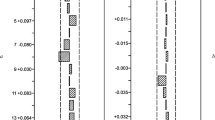An increase in the accuracy of measurements in automatic systems of operational control and regulation by taking into account the error due to the time delay of a discrete reading of the measured value in real time is considered. It is shown that in dynamic measurements of random processes in servo systems, it is necessary to take into account the subjective factor in determining the dynamics of the measured quantities, which consists in the method of assigning the maximum frequency of the spectrum of the initial processes. When calculating the admissible time delay in obtaining the results of discrete measurements in real time, the extrapolation error was taken as a dynamic error. Analytical expressions are obtained to determine the required efficiency of discrete measurements of continuous quantities, taking into account the admissible extrapolation error and the subjective factor of assigning the maximum frequency of the spectrum of the initial process. Three common models of the measured quantity are considered, in which the energy spectrum and the correlation function of the desired random variable are presented as a response to white noise of the ideal, RC and Gaussian low-pass filters. The admissible time delays of discrete samples are calculated depending on the admissible extrapolation error, the extrapolation method, and the maximum frequency of the spectrum of the measured quantity in real-time measurements. It is shown that with a priori uncertainty about the model of the measured value and extrapolation from one or two samples, it is necessary to use a zero-order extrapolator as a prediction algorithm when calculating the admissible time delay. The scientific results obtained in the article will be of interest to specialists in the field of tracking systems, telemechanics, guidance systems, operational control and regulation during real-time measurements in the return information channel.

Similar content being viewed by others
References
A. A. Zheleznjak, “Improving the quality of dynamic process control in electric power systems,” Meas. Monit. Manag. Control, No. 1, 5–12 (2022), https://doi.org/10.21685/2307-5538-2022-1-1.
D. K. Thong, “Synthesis of an optimal missile homing system using the proportional guidance method,” Prib. Sist. Upravl., Kontr., Diagn., 8, 17–24 (2021), https://doi.org/10.25791/pribor.8.2021.1282.
A. A. Zhilenkov and S. G. Chernyj, “Efficiency enhancement of automatic control systems of autonomous drilling rigs due to development of methods providing their compatibility and integration,” Avtomatiz. Telemekh. Svyaz Neft. Prom., No. 4, 9–18 (2015).
A. G. Dmitrienko, A. V. Nikolaev, A. V. Lyashenko, et al., “Elements of development concept for intelligent monitoring and control systems in the items of rocket and space equipment and objects of ground-based space infrastructure,” Meas. Monit. Manag. Control, No. 2 (24), 5–13 (2018), https://doi.org/10.21685/2307-5538-2018-2-1.
K. I. Bastrygin and A. A. Trofimov, “The measurement system, monitoring, control and diagnostics parameters of the rocket engine,” Meas. Monit. Manag. Control, No. 3 (21), 18–25 (2017). https://doi.org/10.21685/2307-5538-2017-3-3.
A. V. Nazarov, G. I. Kozyrev (ed.), and I. V. Shitov, Modern Telemetry in Theory and Practice, Nauka i Tekhnika, St. Petersburg (2007).
I. M. Lebedeva and A. Ju. Fedorova (ed.), Macroeconomic Planning and Forecasting, ITMO, St. Petersburg (2016).
K. Dzerzhek, F. Semenjako, and S. E. Karpovich, “Extrapolation use in numeral systems for motion measurement,” Reports of Belarus. State Univ. of Informatics and Radioelectronics, 1, No. 3, 72–77 (2003).
G. I. Kozyrev, A. N. Kravcov, and V. D. Usikov, “Calculation of the polling frequency in multichannel information-measuring systems from unified energy and accuracy positions,” Meas. Monit. Manag. Control, No. 2 (32), 13–21 (2020), https://doi.org/10.21685/2307-5538-2020-2-2.
O. M. Novoselov and A. F. Fomin, Fundamentals of the Theory and Calculation of Information-Measuring Systems, Mashinostroenie, Moscow (1991), 2nd ed.
G. Korn and T. Korn, Handbook of Mathematics (for scientists and engineers), Nauka, Moscow (1974).
A. Yu. Solodovshhikov and A. K. Platonov, “Study of the Karhunen–Loeve method,” Preprints of the Keldysh IPM, 019 (2006).
M. S. Kirilenko, “Calculation of eigenfunctions of the bounded fractional Fourier transform,” Comp. Optics, 39, No. 3, 332–338 (2015), https://doi.org/https://doi.org/10.18287/0134-2452-2015-39-3-332-338.
Author information
Authors and Affiliations
Corresponding author
Additional information
Translated from Izmeritel’naya Tekhnika, No. 6, pp. 23–27, June, 2022.
Rights and permissions
Springer Nature or its licensor (e.g. a society or other partner) holds exclusive rights to this article under a publishing agreement with the author(s) or other rightsholder(s); author self-archiving of the accepted manuscript version of this article is solely governed by the terms of such publishing agreement and applicable law.
About this article
Cite this article
Kozyrev, G.I., Kibenko, A.V. & Usikov, V.D. Calculation of the Admissible Time Delay of Discrete Samples During Real-Time Measurements. Meas Tech 65, 412–416 (2022). https://doi.org/10.1007/s11018-022-02098-1
Received:
Accepted:
Published:
Issue Date:
DOI: https://doi.org/10.1007/s11018-022-02098-1




